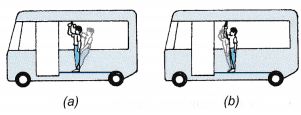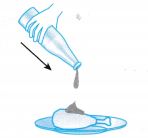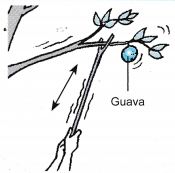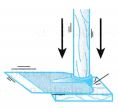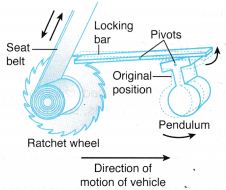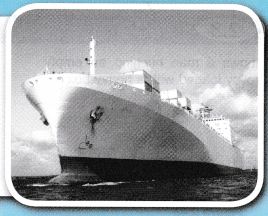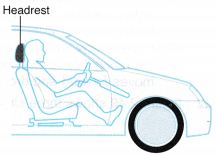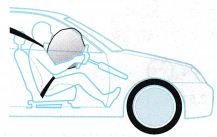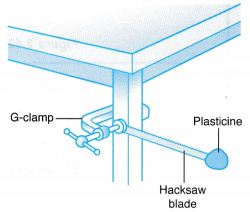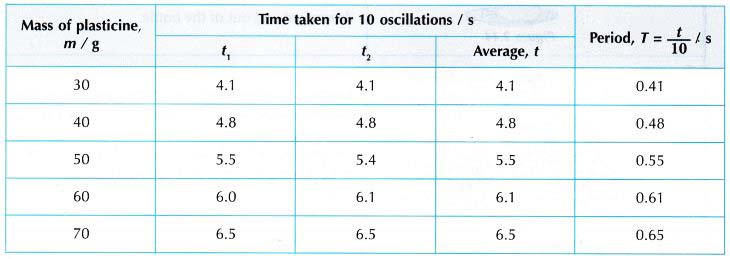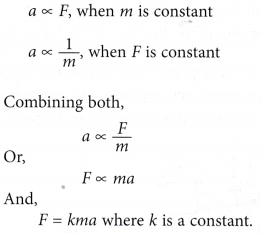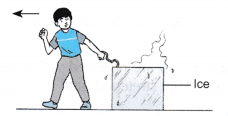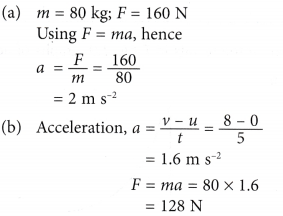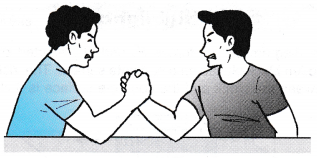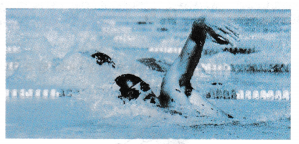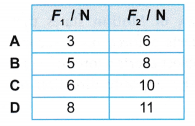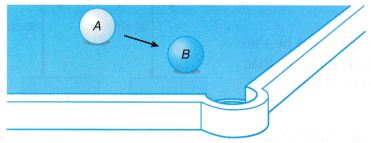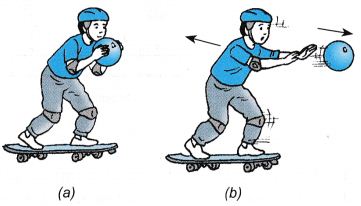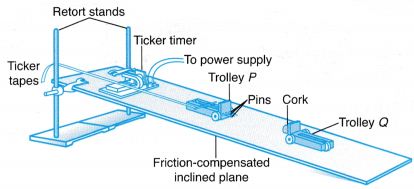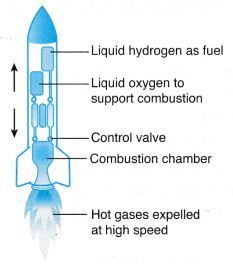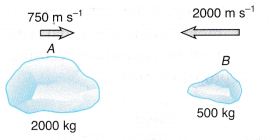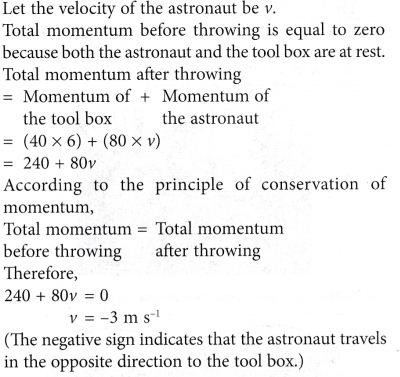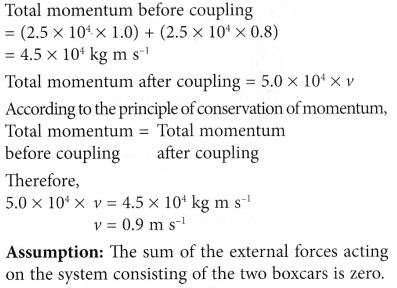Mastering Physics Solutions Chapter 5 Newton’s Laws Of Motion
Mastering Physics Solutions
Chapter 5 Newton’s Laws Of Motion Q.1CQ
Driving down the road, you hit the brakes suddenly. As a result, your body moves toward the front of the car. Explain, using Newton’s laws.
Solution:
When the brakes are applied, the car slows down. The body, however, keeps moving at the same speed. Thus, because of inertia, the body moves toward the front of the car.

Chapter 5 Newton’s Laws Of Motion Q.1P
CE An object of mass m is initially at rest. After a force of magnitude F acts on it for a time T, the object has a speed v. Suppose the mass of the object is doubled, and the magnitude of the force acting on it is quadrupled. In terms of T, how long does it take for the object to accelerate from rest to a speed v now?
Solution:

Chapter 5 Newton’s Laws Of Motion Q.2CQ
You’ve probably seen pictures of someone pulling a tablecloth out from under glasses, plates, and silverware set out for a formal dinner. Perhaps you’ve even tried it yourself. Using Newton’s laws of motion, explain how this stunt works.
Solution:

Chapter 5 Newton’s Laws Of Motion Q.2P
On a planet far, far away, an astronaut picks up a rock. The rock has a mass of 5.00 kg, and on this particular planet its weight is 40.0 N. Tf the astronaut exerts an upward force of 46.2 N on the rock, what is its acceleration?
Solution:


Chapter 5 Newton’s Laws Of Motion Q.3CQ
As you read this, you arc most likely sitting quietly in a chair. Can you conclude, therefore, that you are at rest? Explain.
Solution:
You are not at absolute rest, you are at rest with respect to the other objects in your surroundings. However when you are viewed from other planets, you are not at rest relative to the vantage point of the other planets.
Chapter 5 Newton’s Laws Of Motion Q.3P
In a grocery store, you push a 12.3-kg shopping cart with a force of 10.1 N. If the cart starts at rest, how far does it move in 2.50 s?
Solution:

Chapter 5 Newton’s Laws Of Motion Q.4CQ

Solution:
When a dog shakes its body, the water remains at rest because of inertia. The water drops fall away from the body when the position of the dog’s body is changed rapidly.
Chapter 5 Newton’s Laws Of Motion Q.4P
You are pulling your little sister on her sled across an icy (fric-tionless) surface. When you exert a constant horizontal force of 120 N, the sled has an acceleration of 2.5 m/s2. If the sled has a mass of 7.4 kg, what is the mass of your little sister?
Solution:

Chapter 5 Newton’s Laws Of Motion Q.5CQ
A young girl slides down a rope. As she slides faster and faster she tightens her grip, increasing the force exerted on her by the rope. What happens when this force is equal in magnitude to her weight? Explain.
Solution:

Chapter 5 Newton’s Laws Of Motion Q.5P
· A 0.53-kg billiard ball initially at rest is given a speed of 12 m/s during a time interval of 4.0 ms. What average force acted on the ball during this time?
Solution:

Chapter 5 Newton’s Laws Of Motion Q.6CQ
A drag-racing car accelerates forward because of the force exerted on it by the road. Why, then, does it need an engine? Explain.
Solution:
The drag racer needs an engine to turn the wheels, which in turn makes them push against the ground. When the wheels push against the ground, the ground is able to exert a reaction force on the car to move it.
Chapter 5 Newton’s Laws Of Motion Q.6P
A 92-kg water skier floating in a lake is pulled from rest to a speed of 12 m/s in a distance of 25 m. What is the net force exerted on the skier, assuming his acceleration is constant?
Solution:

Chapter 5 Newton’s Laws Of Motion Q.7CQ

Solution:
(A) The upper string is exposed to two forces. One is the downward weight attached and the other is the force applied. So, in this case, the upper string will break.
(B) Because of the inertia of the block, the lower string will break.
Chapter 5 Newton’s Laws Of Motion Q.7P
CE Predict/Explain You drop two balls of equal diameter from the same height at the same time. Ball 1 is made of metal and has a greater mass than ball 2, which is made of wood. The upward force due to air resistance is the same for both balls, (a) Is the drop time of ball 1 greater than, less than, or equal to the drop time of ball 2? (b) Choose the best explanation from among the following:
I. The acceleration of gravity is the same for all objects, regardless of mass.
II. The more massive ball is harder to accelerate.
III. Air resistance has less effect on the more massive ball.
Solution:


Chapter 5 Newton’s Laws Of Motion Q.8CQ
An astronaut on a space walk discovers that his jet pack no longer works, leaving him stranded 50 m from the spacecraft. If the jet pack is removable, explain how the astronaut can still use it to return to the ship.
Solution:
The astronaut should push the jetpack away from him, in the opposite direction from the spaceship. As a result, the reaction force exerted on him by the pack will accelerate him toward the ship.
Chapter 5 Newton’s Laws Of Motion Q.8P
IP A 42.0-kg parachutist is moving straight downward with a speed of 3.85 m/s. (a) If the parachutist comes to rest with constant acceleration over a distance of 0.750 m, what force does the ground exert on her? (b) If the parachutist comes to rest over a shorter distance, is the force exerted by the ground greater than, less than, or the same as in part (a)? Explain.
Solution:

Chapter 5 Newton’s Laws Of Motion Q.9CQ
Two untethered astronauts on a space walk decide to take a break and play catch with a baseball. Describe what happens as the game of catch progresses.
Solution:
Each time the astronauts catch or throw, an equal and opposite force acts on them. This causes the astronauts to move farther from each other, with increasing speed.
Chapter 5 Newton’s Laws Of Motion Q.9P
IP In baseball, a pitcher can accelerate a 0.15-kg ball from rest to 98 mi/h in a distance of 1.7 m. (a) What is the average force exerted on the ball during the pitch? (b) If the mass of the ball is increased, is the force required of the pitcher increased, decreased, or unchanged? Explain.
Solution:

Chapter 5 Newton’s Laws Of Motion Q.10CQ
What are the action-reaction forces when a baseball bat hits a fast ball? What is the effect of each force?
Solution:
Because of action-reaction forces, the ball will be returned with the same force that the ball applied to the bat.
The force exerted on the bat by the ball is action force, and the force exerted on the ball by the bat is reaction force.
The force exerted on the ball changes its direction.
Chapter 5 Newton’s Laws Of Motion Q.10P
A major-league catcher gloves a 92-mi/h pitch and brings it to rest in 0.15 m. If the force exerted by the catcher is 803 N, what is the mass of the ball?
Solution:

Chapter 5 Newton’s Laws Of Motion Q.11CQ

Solution:
Mr. Ed’s reasoning is incorrect because he is adding two action-reaction forces that act on different objects.
Wilbur should point out that the net force exerted on the cart is simply the force exerted on it by Mr. Ed, and so the cart will accelerate.
The equal and opposite reaction force acts on Mr. Ed, and does not cancel the force acting on the cart.
Chapter 5 Newton’s Laws Of Motion Q.11P

Solution:

Chapter 5 Newton’s Laws Of Motion Q.12CQ
A whole brick has more mass than half a brick, thus the whole brick is harder to accelerate. Why doesn’t a whole brick fall more slowly than half a brick? Explain.
Solution:
The whole brick also experiences twice the gravitational force.
As a result, these two effects (more inertia, more force) cancel each other out exactly. The free-fall acceleration is independent of mass.
Chapter 5 Newton’s Laws Of Motion Q.12P
Stopping a 747 A 747 jetliner lands and begins to slow to a stop as it moves along the runway. If its mass is 3.50 × 105 kg, its speed is 27.0 m/s, and the net braking force is 4.30 × 105 N, (a) what is its speed 7.50 s later? (b) How far has it traveled in this time?
Solution:


Chapter 5 Newton’s Laws Of Motion Q.13CQ
The force exerted by gravity on a whole brick is greater than the force exerted by gravity on half a brick. Why, then, doesn’t a whole brick fall faster than half a brick? Explain.
Solution:
Acceleration of the whole brick is the same as that of half the brick. This is because acceleration is directly proportional to force and inversely proportional to mass.
Chapter 5 Newton’s Laws Of Motion Q.13P
IP A drag racer crosses the finish line doing 202 mi/h and promptly deploys her drag chute (the small parachute used for braking), (a) What force must the drag chute exert on the 891-kg car to slow it to 45.0 mi/h in a distance of 185 m? (b) Describe the strategy you used to solve part (a).
SECTION 5-4 NEWTON’S THIRD LAW OF MOTION
Solution:


Chapter 5 Newton’s Laws Of Motion Q.14CQ
Is it possible for an object at rest to have only a single force acting on it? If your answer is yes, provide an example. If your answer is no, explain why not.
Solution:
No.
If only a single force acts on the object, it will not stay at rest but will accelerate in the direction of the force.
Chapter 5 Newton’s Laws Of Motion Q.14P
CE Predict/Explain A small car collides with a large truck, (a) Is the magnitude of the force experienced by the car greater than, less than, or equal to the magnitude of the force experienced by the truck? (b) Choose the best explanation from among the following:
I. Action-reaction forces always have equal magnitude.
II. The truck has more mass, and hence the force exerted on it is greater.
III. The massive truck exerts a greater force on the lightweight car.
Solution:
(a) The magnitude of the force experienced by the car is equal to magnitude of the force experienced by the truck.
(b) This is because action reaction forces are always equal in magnitude according to ’s third law. So, option I is the best explanation.
Chapter 5 Newton’s Laws Of Motion Q.15CQ
Is it possible for an object to be in motion and yet have zero net force acting on it? Explain.
Solution:
Yes.
When the object is moving with a constant velocity, its acceleration is zero. Thus, the force acting on the object is also zero.
Chapter 5 Newton’s Laws Of Motion Q.15P
CE Predict/Explain A small car collides with a large truck, (a) Is the acceleration experienced by the car greater than, less than, or equal to the acceleration experienced by the truck? (b) Choose the best explanation from among the following:
I. The truck exerts a larger force on the car, giving it the greater acceleration.
II. Both vehicles experience the same magnitude of force, therefore the lightweight car experiences the greater acceleration.
III. The greater force exerted on the truck gives it the greater acceleration.
Solution:
(a) The acceleration experienced by the car is greater than the acceleration experienced by the truck.
(b) This is because of both cars experience same magnitude of force, therefore the lightweight car experiences greater acceleration. So, option II is the best explanation.
Chapter 5 Newton’s Laws Of Motion Q.16CQ
A bird cage, with a parrot inside, hangs from a scale. The parrot decides to hop to a higher perch. What can you say about the reading on the scale (a) when the parrot jumps, (b) when the parrot is in the air, and (c) when the parrot lands on the second perch? Assume that the scale responds rapidly so that it gives an accurate reading at all times.
Solution:
(a) The scale goes down at the moment the parrot jumps.
This happens because the parrot pushes down on its perch in order to jump, and as a result the scale reads a larger value.
(b) When the bird is in the air, the scale just reads the weight of the cage.
(c) When the parrot lands on a higher perch, the scale goes down and then reads a higher value again. This happens because the perch exerts an upward force on the bird in order to bring the bird to rest.
Chapter 5 Newton’s Laws Of Motion Q.16P
You hold a brick at rest in your hand. (a) How many forces act on the brick? (b) Identify these forces, (c) Are these forces equal in magnitude and opposite in direction? (d) Are these forces an action-reaction pair? Explain.
Solution:


Chapter 5 Newton’s Laws Of Motion Q.17CQ
Suppose you jump from the cliffs of Acapulco and perform a perfect swan dive. As you fall, you exert an upward force on the Earth equal in magnitude to the downward force the Earth exerts on you. Why, then, does it seem that you are the one doing all the accelerating? Since the forces are the same, why aren’t the accelerations?
Solution:
The acceleration of a body is inversely proportional to its mass. Earth has a huge mass compared to a man, and so has negligible acceleration towards the man. Thus, the forces are the same but not the accelerations.
Chapter 5 Newton’s Laws Of Motion Q.17P
Referring to Problem 16, you are now accelerating the brick upward, (a) How many forces act on the brick in this case? (b) Identify these forces, (c) Are these forces equal in magnitude and opposite in direction? (d) Are these forces an action-reaction pair? Explain.
Solution:
(A) There are two forces.
(B) Gravitational force and the upward force applied by your hand.
(C) No, these forces are not equal and opposite since the brick is moving up.
(D) No.
Chapter 5 Newton’s Laws Of Motion Q.18CQ
A friend tells you that since his car is at rest, there are no forces acting on it. How would you reply?
Solution:
The car is at rest, and the net force acting on the car is zero.
However, it is wrong to say that no force is acting on the car. When the car is at rest, gravitational force acts on the car, which is balanced by the normal force reaction of the ground upon the car.
Chapter 5 Newton’s Laws Of Motion Q.18P
On vacation, your 1400-kg car pulls a 560-kg trailer away from a stoplight with an acceleration of 1.85 m/s2, (a) What is the net force exerted on the trailer? (b) What force does the traiter exert on the car? (c) What is the net force acting on the car?
Solution:


Chapter 5 Newton’s Laws Of Motion Q.19CQ
Since all objects are “weightless” in orbit, how is it possible for an orbiting astronaut to tell if one object has more mass than another object? Explain.
Solution:
If an astronaut pushes the object, the acceleration can indicate the object’s mass. The heavier mass will have lower acceleration compared to the lighter mass.
Chapter 5 Newton’s Laws Of Motion Q.19P
IP A 71-kg parent and a 19-kg child meet at the center of an ice rink. They place their hands together and push, (a) Is the force experienced by the child more than, less than, or the same as the force experienced by the parent? (b) Is the acceleration of the child more than, less than, or the same as the acceleration of the parent? Explain, (c) If the acceleration of the child is 2.6 m/s2 in magnitude, what is the magnitude of the parent’s acceleration?
Solution:


Chapter 5 Newton’s Laws Of Motion Q.20CQ
To clean a rug, you can hang it from a clothesline and beat it with a tennis racket. Use Newton’s laws to explain why beating the rug should have a cleansing effect.
Solution:
As you hit the rug with the tennis racket you cause it to accelerate rapidly.
The dust from the rug, if it is not attached too firmly, will be left behind as the rug accelerates away from it.
Chapter 5 Newton’s Laws Of Motion Q.20P

Solution:



Chapter 5 Newton’s Laws Of Motion Q.21CQ
If you step off a high board and drop to the water below, you plunge into the water without injury. On the other hand, if you were to drop the same distance onto solid ground, you might break a leg. Use Newton’s laws to explain the difference.
Solution:
When we jump on the ground, we plunge a very small distance compared to jumping into water. The smaller the distance, the larger the acceleration, and thus the greater the force.
Chapter 5 Newton’s Laws Of Motion Q.21P

Solution:


Chapter 5 Newton’s Laws Of Motion Q.22CQ
A moving object is acted on by a net force. Give an example of a situation in which the object moves (a) in the same direction as the net force, (b) at right angles to the net force, or (c) in the opposite direction of the net force.
Solution:
(a) When a cart is pushed forward and set into motion, the direction of the force acting on it and the direction of its motion are equal.
(b) If a ball or any object is thrown up, then, at the top of its flight, its motion is in the horizontal direction. Additionally, the force of gravity acting on the ball (or any object) is in the vertical direction. Here, the direction of force and the direction of motion are perpendicular to each other. In this example, air resistance is neglected.
(c) While you are riding a bicycle, the frictional force acts in the direction opposite to the direction of motion of the bicycle.



Chapter 5 Newton’s Laws Of Motion Q.22P
IP Two boxes sit side-by-side on a smooth horizontal surface. The lighter box has a mass of 5.2 kg; the heavier box has a mass of 7.4 kg. (a) Find the contact force between these boxes when a horizontal force of 5.0 N is applied to the light box. (b) If the 5.0-N force is applied to the heavy box instead, is the contact force between the boxes the same as, greater than, or less than the contact force in part (a)? Explain, (c) Verify your answer to part (b) by calculating the contact force in this case.
Solution:
Chapter 5 Newton’s Laws Of Motion Q.23CQ
Is it possible for an object to be moving in one direction while the net force acting on it is in another direction? If your answer is yes, provide an example. If your answer is no, explain why not.
Solution:
Yes, during the journey of a ball thrown upward, the direction of force is always downward. Thus, the force is in an opposite direction until the ball reaches its maximum height, and then it comes back down.
Chapter 5 Newton’s Laws Of Motion Q.23P
CE A skateboarder on a ramp is accelerated by a nonzero net force. For each of the following statements, state whether it is always true, never true, or sometimes true, (a) The skateboarder is moving in the direction of the net force, (b) The ac-celeration of the skateboarder is at right angles to the net force. (c) The acceleration of the skateboarder is in the same direction as the net force. (d) The skateboarder is instantaneously at rest.
Solution:



Chapter 5 Newton’s Laws Of Motion Q.24CQ
Since a bucket of water is “weightless” in space, would it hurt to kick the bucket? Explain.
Solution:
Answer: Yes
Explanation:
It is given that the bucket of water is weightless in space, but every object has a certain mass, and also has inertia. As inertia is the tendency of a body to resist any change in its state of motion or rest, so when you kick the bucket, it resists a change in its state of motion by exerting an equal and opposite force, which gives the hurt to your foot.
Chapter 5 Newton’s Laws Of Motion Q.24P

Solution:

Chapter 5 Newton’s Laws Of Motion Q.25CQ
In the movie The Rocketeer, a teenager discovers a jet-powered backpack in an old barn. The backpack allows him to fly at incredible speeds. In one scene, however, he uses the backpack to rapidly accelerate an old pickup truck that is being chased by “bad guys.” He does this by bracing his arms against the cab of the pickup and firing the backpack, giving the truck the acceleration of a drag racer. Is the physics of this scene “Good,” “Bad,” or “Ugly?” Explain.
Solution:
This scene is an example of bad physics. It is true that the jet-powered backpack produces enough force to push the truck, but this force is imparted to the truck through the arms of the teenager. This is a very unrealistic situation, because force that is great enough to accelerate an old truck would likely crush the teenager’s arms.
Chapter 5 Newton’s Laws Of Motion Q.25P
A farm tractor tows a 3700-kg trailer up an 18° incline with a steady speed of 3.2 m/s. What force does the tractor exert on the trailer? (Ignore friction.)
Solution:


Chapter 5 Newton’s Laws Of Motion Q.26CQ
List three common objects that have a weight of approximately 1 N.
Solution:
Any object whose weight is approximately 100g has a weight equal to 1N
(i) An apple weighs approximately 1N
(ii) A chocolate bar
(iii) A pack of crayons
Chapter 5 Newton’s Laws Of Motion Q.26P
A surfer “hangs ten,” and accelerates down the sloping face of a wave. If the surfer’s acceleration is 3.25 m/s2 and friction can be ignored, what is the angle at which the face of the wave is inclined above the horizontal?
Solution:

Chapter 5 Newton’s Laws Of Motion Q.27P

Solution:



Chapter 5 Newton’s Laws Of Motion Q.28P

Solution:

Chapter 5 Newton’s Laws Of Motion Q.29P

Solution:


Chapter 5 Newton’s Laws Of Motion Q.30P

Solution:


Chapter 5 Newton’s Laws Of Motion Q.31P
IP Before practicing his routine on the rings, a 67-kg gymnast stands motionless, with one hand grasping each ring and his feet touching the ground. Both aims slope upward at an angle of 24° above the horizontal, (a) If the force exerted by the rings on each arm has a magnitude of 290 N, and is directed along the length of the arm, what is the magnitude of the force exerted by the floor on his feet? (b) If the angle his arms make with the horizontal is greater that 24°, and everything else remains the same, is the force exerted by the floor on his feet greater than, less than, or the same as the valne found in part (a)? Explain.
Solution:


Chapter 5 Newton’s Laws Of Motion Q.32P

Solution:


Chapter 5 Newton’s Laws Of Motion Q.33P
An object acted on by three forces moves with constant velocity. One force acting on the object is in the positive x direction and has a magnitude of 6.5 N; a second force has a magnitude of 4.4 N and points in the negative y direction. Find the direction and magnitude of the third force acting on the object.
Solution:


Chapter 5 Newton’s Laws Of Motion Q.34P
· A train is traveling up a 3.73° incline at a speed of 3.25 m/s when the last car breaks free and begins to coast without friction, (a) How long does it take for the last car to come to rest momentarily? (b) How far did the last car travel before mo-mentarily coming to rest?
Solution:


Chapter 5 Newton’s Laws Of Motion Q.35P

Solution:




Chapter 5 Newton’s Laws Of Motion Q.36P
You pull upward on a stuffed suitcase with a force of 105 N, and it accelerates upward at 0.705 m/s2. What are (a) the mass and (b) the weight of the suitcase?
Solution:


Chapter 5 Newton’s Laws Of Motion Q.37P
BIO Brain Growth A newborn baby’s brain grows rapidly. In fact, it has been found to increase in mass by about 1.6 mg per minute, (a) How much does the brain’s weight increase in one day? (b) How long does it take for the brain’s weight to increase by 0.15 N?
Solution:


Chapter 5 Newton’s Laws Of Motion Q.38P
Suppose a rocket launches with an acceleration of 30.5 m/s2. What is the apparent weight of an 92-kg astronaut aboard this rocket?
Solution:

Chapter 5 Newton’s Laws Of Motion Q.39P
At the bow of a ship on a stormy sea, a crewman conducts an experiment by standing on a bathroom scale. In calm waters, the scale reads 182 lb. During the storm, the crewman finds a maximum reading of 225 lb and a minimum reading of 138 lb. Find (a) the maximum upward acceleration and (b) the maximum downward acceleration experienced by the crewman.
Solution:




Chapter 5 Newton’s Laws Of Motion Q.40P
IP As part of a physics experiment, you stand on a bathroom scale in an elevator. Though your normal weight is 610 N, the scale at the moment reads 730 N. (a) Is the acceleration of the elevator upward, downward, or zero? Explain. (b) Calculate the magnitude of the elevator’s acceleration. (c) What, if anything, can you say about the velocity of the elevator? Explain.
Solution:


Chapter 5 Newton’s Laws Of Motion Q.41P
When you weigh yourself on good old terra firma (solid ground), your weight is 142 lb. In an elevator your apparent weight is 121 lb. What are the direction and magnitude of the elevator’s acceleration?
Solution:


Chapter 5 Newton’s Laws Of Motion Q.42P

Solution:


Chapter 5 Newton’s Laws Of Motion Q.43PWhen you lift a bowling ball with a force of 82 N, the ball accelerates upward with an acceleration a. If you lift with a force of 92 N, the ball’s acceleration is 2a. Find (a) the weight of the bowling ball, and (b) the acceleration a.
Solution:

Chapter 5 Newton’s Laws Of Motion Q.44P
A 23-kg suitcase is being pulled with constant speed by a handle that is at an angle of 25° above the horizontal. If the normal force exerted on the suitcase is 180 N, what is the force F applied to the handle?
Solution:

Chapter 5 Newton’s Laws Of Motion Q.45P
(a) Draw a free-body diagram for the skier in Problem 32. (b) Determine the normal force acting on the skier.
Solution:

Chapter 5 Newton’s Laws Of Motion Q.46P
· A 9.3-kg child sits in a 3.7-kg high chair. (a) Draw a free-body diagram for the child, and find the normal force exerted by the chair on the child. (b) Draw a free-body diagram for the chair, and find the normal force exerted by the floor on the chair.
Solution:


Chapter 5 Newton’s Laws Of Motion Q.47P

Solution:



Chapter 5 Newton’s Laws Of Motion Q.48P
A 5.0-kg bag of potatoes sits on the bottom of a stationary shopping cart. (a) Sketch a free-body diagram for the bag of potatoes. (b) Now suppose the cart moves with a constant velocity. How does this affect your free-body diagram? Explain.
Solution:

Chapter 5 Newton’s Laws Of Motion Q.49P
IP (a) Find the normal force exerted on a 2.9-kg book resting on a surface inclined at 36° above the horizontal. (b) If the angle of the incline is reduced, do you expect the normal force to increase, decrease, or stay the same? Explain.
Solution:


Chapter 5 Newton’s Laws Of Motion Q.50P
IP A gardener mows a lawn with an old-fashioned push mower. The handle of the mower makes an angle of 35° with the surface of the lawn. (a) If a 219-N force is applied along the handle of the 19-kg mower, what is the normal force exerted by the lawn on the mower? (b) If the angle between the surface of the lawn and the handle of the mower is increased, does the normal force exerted by the lawn increase, decrease, or stay the same? Explain.
Solution:


Chapter 5 Newton’s Laws Of Motion Q.51P

Solution:


Chapter 5 Newton’s Laws Of Motion Q.52GP
·CE Predict/Explain Riding in an elevator moving upward with constant speed, you begin a game of darts. (a) Do you have to aim your darts higher than, lower than, or the same as when you play darts on solid ground? (b) Choose the best explanation from among the following:
I. The elevator rises during the time it takes for the dart to travel to the darfboard.
II. The elevator moves with constant velocity. Therefore, Newton’s laws apply within the elevator in the same way as on the ground.
III. You have to aim lower to compensate for the upward speed of the elevator.
Solution:
(a) You have to aim your darts same as when you play darts on solid ground.
(b) This is because the elevator is moving with constant velocity. Therefore ’s laws apply within the elevator in the same way as on earth.
Therefore option II is best explanation.
Chapter 5 Newton’s Laws Of Motion Q.53GP
CE Predict/Explain Riding in an elevator moving with a constant upward acceleration, you begin a game of darts. (a) Do you have to aim your darts higher than, lower than, or the same as when you play darts on solid ground? (b) Choose the best explanation from among the following:
I. The elevator accelerates upward, giving its passengers a greater “effective” acceleration of gravity.
II. You have to aim lower to compensate for the upward acceleration of the elevator.
III. Since the elevator moves with a constant acceleration, Newton’s laws apply within the elevator the same as on the ground.
Solution:
In the game of darts a player have to aim and throw the dart on the board to hit the bulls- eye.
(a)
When elevator is going upward with constant acceleration the board hanged on wall of the elevator will also move upward with same acceleration. When a person will throw a dart it will immediately start accelerating downward on the other hand board will keep accelerating upward. Therefore dart will not hit the aimed position. It will hit lower than the aimed position.
Hence in the accelerating elevator a person has to aim his darts higher than the normal.
(b)
When the elevator is accelerating upward then due to force exerted by the floor of the elevator effective acceleration of the passenger increases. Therefore first explanation is right.
As discussed in previous section passenger has aim higher to compensate for the upward acceleration. Therefor second explanation is wrong.
Newton’s law can be applied directly only for inertial reference frame (stationary reference point or moving with constant reference point). Since elevator is moving with constant acceleration therefore newton’s law applied within the elevator is not same as on the ground. Therefore third explanation is wrong
Hence option I is the best explanation.
Chapter 5 Newton’s Laws Of Motion Q.54GP
CE Give the direction of the net force acting on each of the following objects. If the net force is zero, state “zero.” (a) A car accelerating northward from a stoplight. (b) A car traveling southward and slowing down. (c) A car traveling westward with constant speed. (d) A skydiver parachuting downward with constant speed. (e) A baseball during its flight from pitcher to catcher (ignoring air resistance).
Solution:

Chapter 5 Newton’s Laws Of Motion Q.55GP
·CE Predict/Explain You jump out of an airplane and open your parachute after an extended period of free fall. (a) To decelerate your fall, must the force exerted on you by the parachute be greater than, less than, or equal to your weight? (b) Choose the best explanation from among the following:
I. Parachutes can only exert forces that are less than the weight of the skydiver.
II. The parachute exerts a force exactly equal to the skydiver’s weight.
III. To decelerate after free fall, the net force acting on a skydiver must be upward.
Solution:
(a) To decelerate your fall the force exerted by the parachute must be greater than your weight.
(b) To decelerate after free fall, the net force acting on a sky diver must be upward. This can be achieved only when the force exerted by the parachute is greater than your weight
So option III is the best explanation.
Chapter 5 Newton’s Laws Of Motion Q.56GP
In a tennis serve, a 0.070-kg ball can be accelerated from rest to 36 m/s over a distance of 0.75 m. Find the magnitude of the average force exerted hy the racket on the ball during the serve.
Solution:

Chapter 5 Newton’s Laws Of Motion Q.57GP
A 51.5-kg swimmer with an initial speed of 1.25 m/s decides to coast until she comes to rest. If she slows with constant acceleration and stops after coasting 2.20 m, what was the force exerted on her by the water?
Solution:


Chapter 5 Newton’s Laws Of Motion Q.58GP

Solution:
The three identical pucks are acted upon by a force of 3N.
F = ma
Since the mass and the force of the 3 pucks are the same, then the acceleration produced by this force must also be the same. The acceleration produced by a force does not depend on the speed of the object, so the acceleration of A, B, and C are all equal.
Chapter 5 Newton’s Laws Of Motion Q.59GP
IP The VASIMR Rocket NASA plans to use a new type of rocket, a Variable Specific Impulse Magnetoplasma Rocket (VASIMR), on future missions. A VASIMR can produce 1200 N of thrust (force) when in operation. If a VASIMR has a mass of 2.2 × 105 kg, (a) what acceleration will it experience? Assume that the only force acting on the rocket is its own thrust, and that the mass of the rocket is constant. (b) Over what distance must the rocket accelerate from rest to achieve a speed of 9500 m/s? (c) When the rocket has covered one-quarter the acceleration distance found in part (b), is its average speed 1/2, 1/3, or 1/4 its average speed during the final three-quarters of the acceleration distance? Explain.
Solution:

Chapter 5 Newton’s Laws Of Motion Q.60GP

Solution:

Chapter 5 Newton’s Laws Of Motion Q.61GP
At the local grocery store, you push a 14.5-kg shopping cart. You stop for a moment to add a bag of dog food to your cart. With a force of 12.0 N, you now accelerate the cart from rest through a distance of 2.29 m in 3.00 s. What was the mass of the dog food?
Solution:

Chapter 5 Newton’s Laws Of Motion Q.62GP
· IP BIO The Force of Running Biomechanical research has shown that when a 67-kg person is running, the force exerted oh each foot as it strikes the ground can be as great as 2300 N. (a) What is the ratio of the force exerted on the foot by the ground to the person’s body weight? (b) If the only forces acting on the person are (i) the force exerted by the ground and (ii) the person’s weight, what are the magnitude and direction of the person’s acceleration? (c) If the acceleration found in part (b) acts for 10.0 ms, what is the resulting change in the vertical component of the person’s velocity?
Solution:


Chapter 5 Newton’s Laws Of Motion Q.63GP
IP BIO Grasshopper Liftoff To become airborne, a 2.0-g grasshopper requires a takeoff speed of 2.7 m/s. It acquires this speed by extending its hind legs through a distance of 3.7 cm. (a) What is the average acceleration of the grasshopper during takeoff? (b) Find the magnitude of the average net force exerted
on the grasshopper by its hind legs during takeoff. (c) If the mass of the grasshopper increases, does the takeoff acceleration increase, decrease, or stay the same? (d) If the mass of the grasshopper increases, does the required takeoff force increase, decrease, or stay the same? Explain.
Solution:


Chapter 5 Newton’s Laws Of Motion Q.64GP

Solution:

Chapter 5 Newton’s Laws Of Motion Q.65GP
IP An archer shoots a 0.024-kg arrow at a target with a speed of 54 m/s. When it hits the target, it penetrates to a depth of 0.083 m. (a) What was the average force exerted by the target on the arrow? (b) If the mass of the arrow is doubled, and the force exerted by the target on the arrow remains the same, by what multiplicative factor does the penetration depth change? Explain.
Solution:


Chapter 5 Newton’s Laws Of Motion Q.66GP
An apple of mass m = 0.13 kg falls out of a tree from a height h = 3.2 m. (a) What is the magnitude of the force of gravity, mg, acting on the apple? (b) What is the apple’s speed, v, just before it lands? (c) Show that the force of gravity times the height, mgh, is equal to . (We shall investigate the significance of this result in Chapter 8.) Be sure to show that the dimensions are in agreement as well as the nu-merical values.
Solution:


Chapter 5 Newton’s Laws Of Motion Q.67GP
An apple of mass m = 0.22 kg falls from a tree and hits the ground with a speed of v = 14 m/s. (a) What is the magnitude of the force of gravity, mg, acting on the apple? (b) What is the time, t, required for the apple to reach the ground? (c) Show that the force of gravity times the time, mgt, is equal to mv. (We shall investigate the significance of this result in Chapter 9.) Be sure to show that the dimensions are in agreement as well as the numerical values.
Solution:

Chapter 5 Newton’s Laws Of Motion Q.68GP
BIO The Fall of T. rex Paleontologists estimate that if a Tyrnnnosaunis rex were to trip and fall, it would have experienced a force of approximately 260,000 N acting on its torso when it hit the ground. Assuming the torso has a mass of 3800 kg, (a) find the magnitude of the torso’s upward acceleration as it comes to rest. (For comparison, humans lose consciousness with an acceleration of about 7g.) (b) Assuming the torso is in free fall for a distance of 1.46 m as it falls to the ground, how much time is required for the torso to come to rest once it contacts the ground?
Solution:


Chapter 5 Newton’s Laws Of Motion Q.69GP
Deep Space I The NASA spacecraft Deep Space I was shut down on December 18, 2001, following a three-year journey to the asteroid Braille and the comet Borrelly. This spacecraft used a solar-powered ion engine to produce 0.064 ounces of thrust (force) by stripping electrons from neon atoms and accelerating the resulting ions to 70,000 mi/h. The thrust was only as much as the weight of a couple sheets of paper, but the engine operated continuously for 16,000 hours. As a result, the speed of the spacecraft increased by 7900 mi/h. What was the mass of Deep Space I? (Assume that the mass of the neon gas is negligible.)
Solution:


Chapter 5 Newton’s Laws Of Motion Q.70GP
Your groceries are in a bag with paper handles. The handles will tear off if a force greater than 51.5 N is applied to them. What is the greatest mass of groceries that can be lifted safely with this bag, given that the bag is raised (a) with constant speed, or (b) with an acceleration of 1.25 m/s2?
Solution:


Chapter 5 Newton’s Laws Of Motion Q.71GP
IP While waiting at the airport for your flight to leave, you observe some of the jets as they take off. With your watch you find that it takes about 35 seconds for a plane to go from rest to takeoff speed. In addition, you estimate that the distance re-quired is about 1.5 km. (a) If the mass of a jet is 1.70 × 105 kg, what force is needed for takeoff? (b) Describe the strategy you used to solve part (a).
Solution:

Chapter 5 Newton’s Laws Of Motion Q.72GP

Solution:


Chapter 5 Newton’s Laws Of Motion Q.73GP
Your groceries are in a bag with paper handles. The handles will tear off if a force greater than 51.5 N is applied to them. What is the greatest mass of groceries that can be lifted safely with this bag, given that the bag is raised (a) with constant speed, or (b) with an acceleration of 1.25 m/s2?
Solution:
The Newton’s second law of motion defined the acceleration of an object produced by a net force is directly proportional to the magnitude of net force and inversely proportional to the mass of object.
The force acting on mass m moves with acceleration a is given as follows:
F=ma
Here, m is the mass and a is the acceleration.

Chapter 5 Newton’s Laws Of Motion Q.74GP
IP Responding to an alarm, a 102-kg fireman slides down a pole to the ground floor, 3.3 m below. The fireman starts at rest and lands with a speed of 4.2 m/s. (a) Find the average force exerted on the fireman by the pole. (b) If the landing speed is half that in part (a), is the average force exerted on the fireman by the pole doubled? Explain. (c) Find the average force exerted on the fireman by the pole when the landing speed is 2.1 m/s.
Solution:



Chapter 5 Newton’s Laws Of Motion Q.75GP
For a birthday gift, you and some friends take a hot-air balloon ride. One friend is late, so the balloon floats a couple of feet off the ground as you wait. Before this person arrives, the combined weight of the basket and people is 1220 kg, and the balloon is neutrally buoyant. When the late arrival climbs up into the basket, the balloon begins to accelerate downward at 0.56 m/s2. What was the mass of the last person to climb aboard?
Solution:


Chapter 5 Newton’s Laws Of Motion Q.76GP
D:\APLUS images\Mastering Physics Solutions Chapter 5 Newton’s Laws Of Motion75gps1.png
Solution:

Chapter 5 Newton’s Laws Of Motion Q.77GP
When two people push in the same direction on an object of mass m they cause an acceleration of magnitude a1. When the same people push in opposite directions, the acceleration of the object has a magnitude a2. Determine the magnitude of the force exerted by each of the two people in terms of m, a1 and a2.
Solution:


Chapter 5 Newton’s Laws Of Motion Q.78GP
· · · An air-track cart of mass m1 = 0.14 kg is moving with a speed v0 = 1.3 m/s to the right when it collides with a cart of mass m2 = 0.25 kg that is at rest. Each cart has a wad of putty on its bumper, and hence they stick together as a result of their collision. Suppose the average contact force between the carts is F = 1.5 N during the collision. (a) What is the acceleration of cart 1? Give direction and magnitude. (b) What is the acceleration of cart 2? Give direction and magnitude. (c) How long does it take for both carts to have the same speed? (Once the carts have the same speed the collision is over and the contact force vanishes.) (d) What is the final speed of the carts, vf? (e) Show that m1v0 is equal to (m1 + m2)vf. (We shall investigate the significance of this result in Chapter 9.)
Solution:




Chapter 5 Newton’s Laws Of Motion Q.79PP

Solution:

Chapter 5 Newton’s Laws Of Motion Q.80PP
A driver who does not wear a seatbelt continues to move forward with a speed of 18.0 m/s (due to inertia) until something solid like the steering wheel is encountered. The driver now comes to rest in a much shorter distance—perhaps only a few centimeters. Find the magnitude of the net force acting on a 65.0-kg driver who is decelerated from 18.0 m/s to rest in 5.00 cm.
A. 3240 N
B. 1.17 × 104 N
C. 2.11 × 105 N
D. 4.21 × 105 N
Solution:

Chapter 5 Newton’s Laws Of Motion Q.81PP
Suppose the initial speed of the driver is doubled to 36.0 m/s. If the driver still has a mass of 65.0 kg, and comes to rest in 1.00 m, what is the magnitude of the force exerted on the driver during this collision?
A. 648 N
B. 1170 N
C. 2.11 × 104 N
D. 4.21 × 104 N
Solution:

Chapter 5 Newton’s Laws Of Motion Q.82PP
If both the speed and stopping distance of a driver are doubled, by what factor does the force exerted on the driver change?
A. 0.5
B. 1
C. 2
D. 4
Solution:


Chapter 5 Newton’s Laws Of Motion Q.83IP
IP Referring to Example 5-4 Suppose that we would like the contact force between the boxes to have a magnitude of 5.00 N, and that the only thing in the system we are allowed to change is the mass of box 2—the mass of box 1 is 10.0 kg and the applied force is 20.0 N. (a) Should the mass of box 2 be increased or decreased? Explain. (b) Find the mass of box 2 that results in a contact force of magnitude 5.00 N. (c) What is the acceleration of the boxes in this case?
Solution:




Chapter 5 Newton’s Laws Of Motion Q.84IP
Referring to Example 5-4 Suppose the force of 20.0 N pushes on two boxes of unknown mass. We know, however, that the acceleration of the boxes is 1.20 m/s2 and the contact force has a magnitude of 4.45 N. Find the mass of (a) box 1 and (b) box 2.
Solution:



Chapter 5 Newton’s Laws Of Motion Q.85IP
IP Referring to Figure 5-9 Suppose the magnitude of is increased from 41 N to 55 N, and that everything else in the system remains the same. (a) Do you expect the direction of the satellite’s acceleration to be greater than, less than, or equal to 32°? Explain. Find (b) the direction and (c) the magnitude of the satellite’s acceleration in this case.
Solution:




Chapter 5 Newton’s Laws Of Motion Q.86IP
IP Referring to Figure 5-9 Suppose we would like the acceleration of the satellite to be at an angle of 25°, and that the only quantity we can change in the system is the magnitude of . (a) Should the magnitude of be increased or decreased? Explain. (b) What is the magnitude of the satellite’s acceleration in this case?
Solution:





